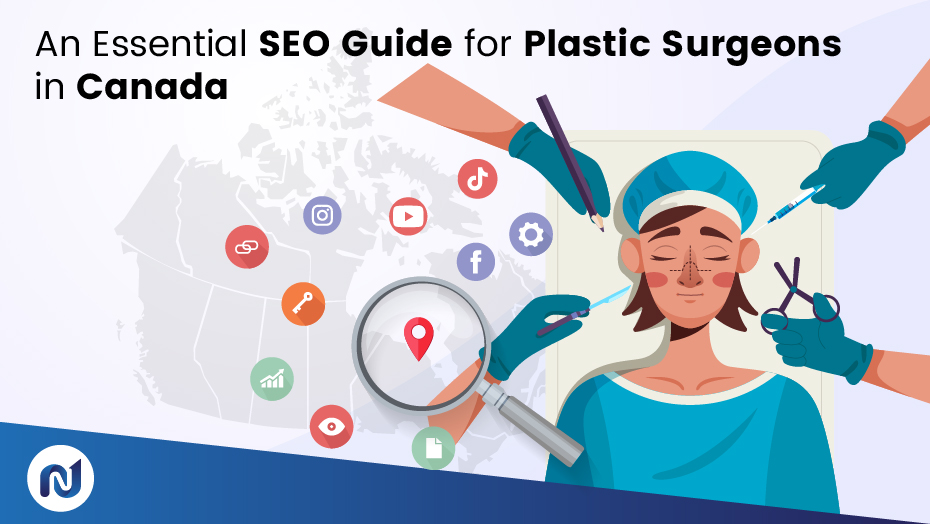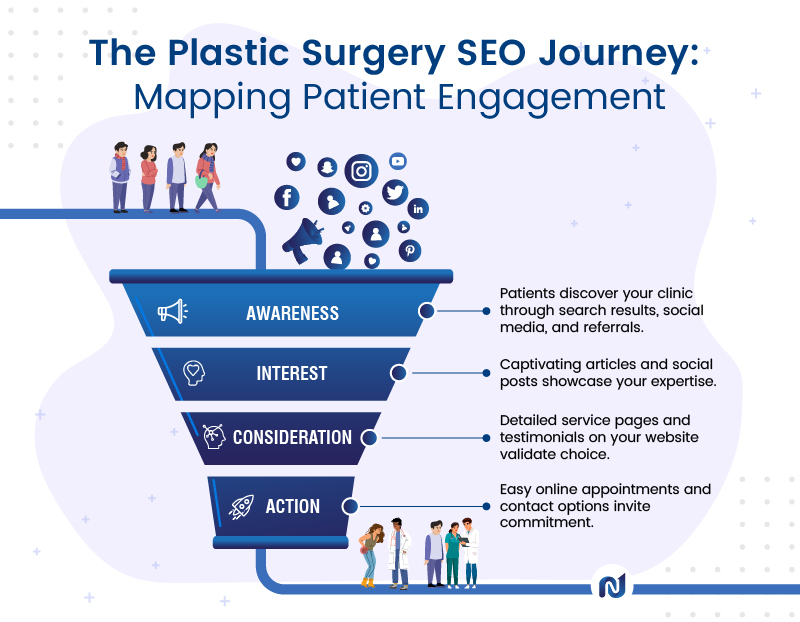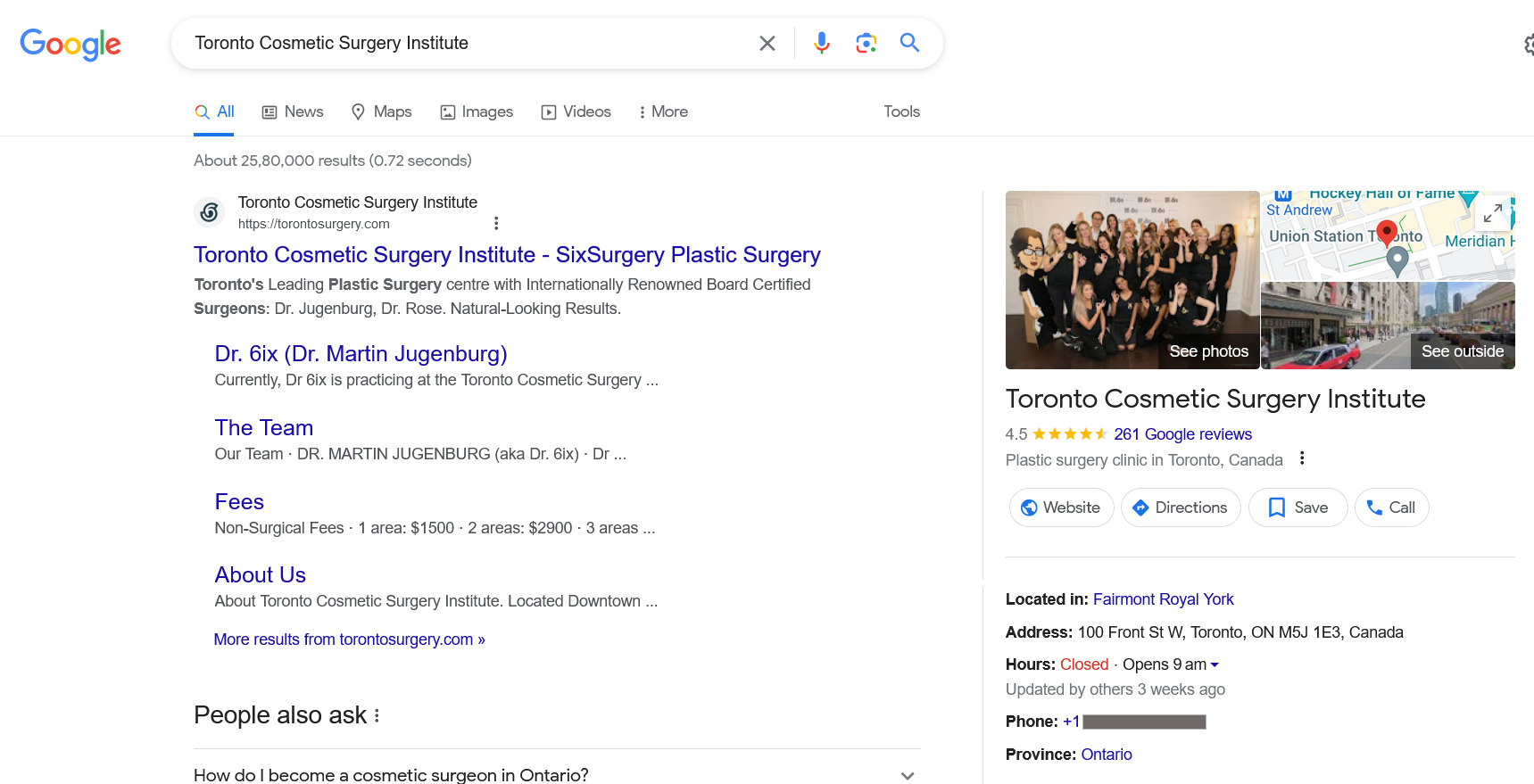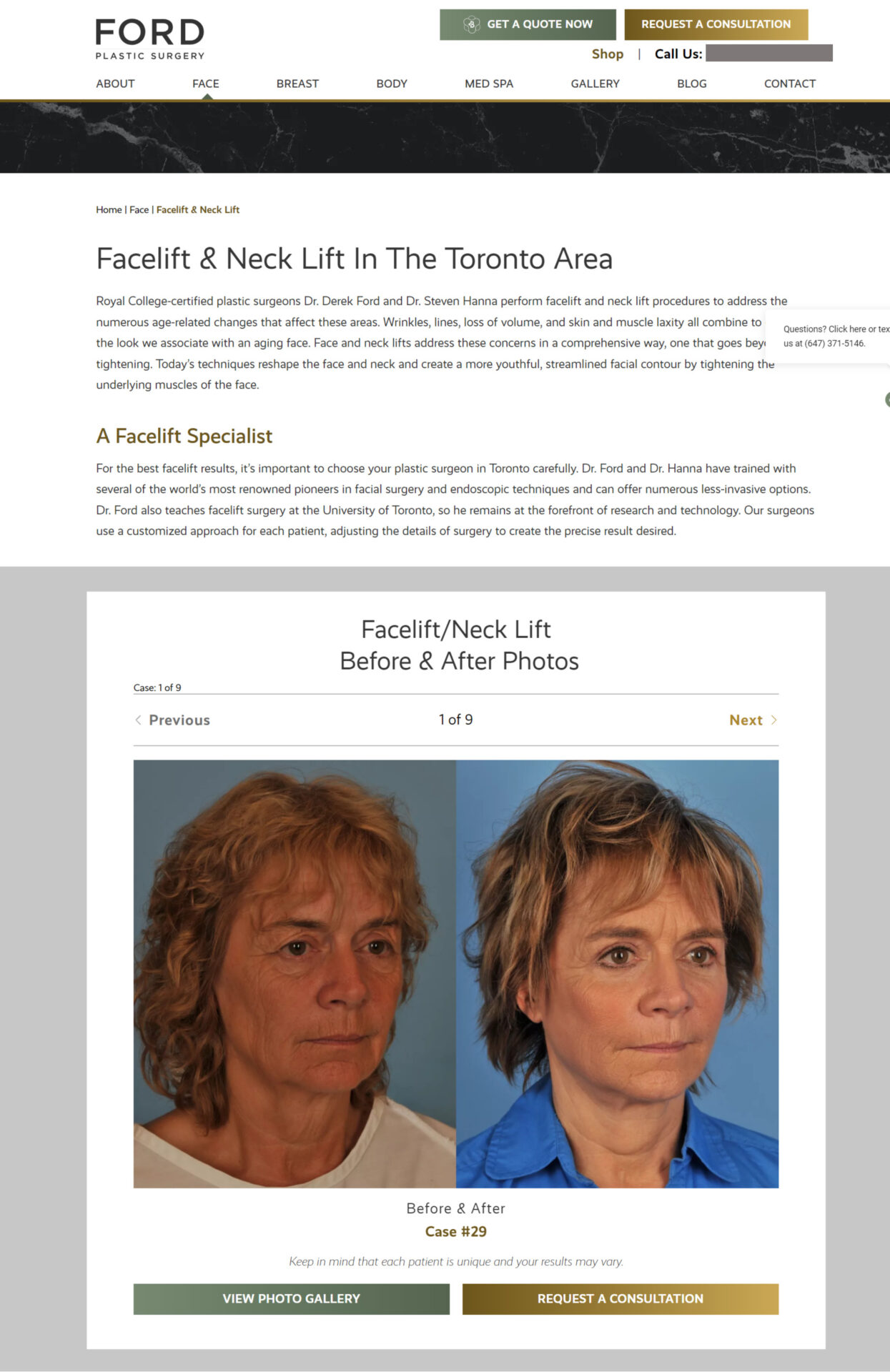
How does your plastic surgery clinic become the first choice for potential patients? It’s all about strategically using SEO.
In this guide, we’ll introduce you to SEO techniques that can transform your plastic surgery practice’s online presence. We’ll show you how to make your clinic stand out, attract the right patients, and keep them engaged throughout their decision-making journey. From first glance to final consultation, your SEO-driven website is your most powerful tool. Are you ready to optimize your practice for success?
Table of Contents
- The Plastic Surgery Marketing Funnel and SEO
- Developing an SEO Strategy Aligned with the Marketing Funnel
- Website and Content Optimization for Each Funnel Stage
- Leveraging Social Media and Multimedia Content
- Managing Your Online Reputation and Reviews
- Advanced SEO Techniques and Analytics
- SEO Compliance, Ethics, and Best Practices
- Integrating SEO with Your Overall Marketing Efforts
- Conclusion: Embracing SEO for Sustainable Growth
The Plastic Surgery Marketing Funnel and SEO
The marketing funnel mirrors the patient’s journey from learning about your clinic to deciding to proceed with a procedure. Each phase—Awareness, Interest, Consideration, Action—is a chance for your practice to make meaningful connections and engage with potential patients. By crafting an SEO strategy that provides timely and relevant information, you guide them step by step, ensuring your practice is with them at every important moment of their decision-making process.

Developing an SEO Strategy Aligned with the Marketing Funnel
Target Audience Identification and Market Analysis in Canada
(Awareness and Interest stages)
Understanding your target audience is key to tailoring your SEO strategy. Knowing who your patients are helps in creating targeted content and choosing relevant keywords for the Awareness and Interest stages of the funnel. Different procedures and services appeal to different demographics. It’s important to consider factors like age, lifestyle, and the specific needs of patients. For example, younger patients might be more interested in cosmetic enhancements, while older demographics might seek reconstructive or anti-aging treatments. Knowing this helps in creating targeted content and choosing relevant keywords.
| Procedure Type | Target Demographic Example | Content Focus Example |
| Cosmetic Enhancements | Young adults seeking aesthetic improvements | “Minimally invasive facial rejuvenation in Toronto” |
| Reconstructive Surgeries | Individuals recovering from accidents | “Advanced reconstructive surgery techniques in Halifax” |
| Anti-Aging Treatments | Middle-aged demographic | “Innovative anti-aging treatments in Montreal” |
| Non-Surgical Procedures | Health-conscious individuals | “Non-surgical body contouring options in Calgary” |
Keyword Research for Your Plastic Surgery Clinic
(Awareness, Interest, Consideration stages)
Effective keyword research involves identifying terms that potential patients will likely use when searching for your services, ensuring your content is visible at the right stage in their decision-making process. For each funnel stage, identify keywords that align with patient intentions. Tools like Google Keyword Planner can be invaluable here. For Awareness, broad terms like “cosmetic surgery in Toronto” work well. As they move down the funnel, more specific keywords like “best rhinoplasty surgeon in Vancouver” gain importance. This ensures your content is visible to the right audience at the right time in their decision-making process.
| Funnel Stage | Keyword Type | Example Keywords |
| Awareness | Broad, general terms | “Cosmetic surgery options in Canada”, “Plastic surgeons in Quebec” |
| Interest | Service-specific terms | “Nose job procedures in Winnipeg”, “Laser skin treatment in Edmonton” |
| Consideration | Detailed, procedure-specific | “Best breast augmentation in Ottawa”, “Eyelid surgery costs in Toronto” |
| Action | Direct call-to-action terms | “Book consultation for liposuction in Vancouver”, “Contact top plastic surgeon in Halifax” |
Local SEO for Plastic Surgeons
(Consideration and Action stages)
Optimizing your Local SEO is essential, as most patients prefer to find services within their local area. This involves using location-specific keywords and ensuring accurate listings on platforms like Google Business Profile, Apple Connect, and Bing Places. Paying attention to these listings is particularly important during the Consideration and Action stages of the funnel. Why? Because they not only increase your visibility in local search results but also help your practice rank in the Google Local Pack and on Google Maps.
To enhance your practice’s online presence, it’s crucial to have accurate NAP (Name, Address, Phone) information and comprehensive listings on these platforms. This makes it easier for potential patients in your area to find you. To develop an effective Local SEO strategy, incorporate location-specific keywords in your website’s metadata, content, and backlinks. By doing so, you can improve your practice’s visibility and attract more local patients.
| SEO Aspect | Implementation Example | Benefit |
| Location-Based Keywords | “Breast augmentation in Halifax”, “Lip fillers in Quebec City” | Targets local patients searching for specific services |
| Google Business Profile | Accurate clinic details, reviews, and operational hours | Boosts visibility in Google Maps and Local Pack |
| Apple Connect and Bing Places | Consistent listing information across platforms | Expands online presence beyond Google |

Website and Content Optimization for Each Funnel Stage
Site Structure and User Experience
Your website is often patients’ first interaction with your practice. Make it count. A well-structured website with an intuitive user experience is essential for attracting and retaining visitors. This includes a clean layout, easy navigation, and fast load times. A mobile-responsive design is crucial, as many users will access your site on mobile devices. The goal is to make information about your services easily accessible and engaging.
| Aspect | Example | Importance |
| Clean Layout | Minimalistic design with clear service categories | Enhances user engagement |
| Easy Navigation | Drop-down menus for different surgery types | Facilitates easy discovery of services |
| Fast Load Times | Optimized images and streamlined coding | Reduces bounce rates |
| Mobile Responsiveness | Responsive design adaptable to various screen sizes | Improves experience for mobile users |
Content Marketing
Content marketing is the art of curating and sharing informative, engaging content that resonates with your audience. For plastic surgeons, this means providing a treasure trove of knowledge through well-researched blog posts, comprehensive FAQs, and in-depth procedure breakdowns. The goal? To inform, educate, and reassure potential patients as they navigate their options. Excelling in content marketing not only establishes your clinic as an authoritative voice in the field but also builds a bridge of trust with those considering your services. It’s about giving them all the pieces they need to complete the puzzle of their plastic surgery journey.
| Content-Type | Example | Purpose |
| Blog Posts | “The Latest Advances in Rhinoplasty” | Educates and engages potential patients |
| FAQs | Common questions about breast augmentation | Addresses patient concerns and queries |
| Procedure Descriptions | Detailed guide on the liposuction process | Provides clear and comprehensive information |
| Testimonials | Patient success stories | Builds trust and credibility |
Creating Service Pages
Ensure that each service you offer has its own dedicated page on your website. These pages should be informative, visually appealing, and optimized for SEO. Include essential details such as the procedure process, benefits, recovery time, and before-and-after photos. By providing this comprehensive information, you will help patients in the Consideration stage understand what to expect and why they should choose your practice. Building trust and credibility is crucial, so remember to incorporate patient testimonials alongside detailed procedure descriptions and captivating before-and-after photos.
| Service | Page Elements | Impact |
| Facelift | Procedure steps, recovery tips, patient photos | Informs and builds confidence in the service |
| Botox | FAQs, benefits, expected results | Educates on non-surgical options |
| Tummy Tuck | Preparation guidelines, recovery timeline | Sets realistic expectations for patients |
| Skin Rejuvenation | Technology used, before-and-after gallery | Showcases expertise and results |

Source: https://www.fordplasticsurgery.com/face/facelift-neck-lift/
Leveraging Social Media and Multimedia Content
Social media is a powerful tool for building brand awareness and engagement. Platforms like Instagram and YouTube are perfect for showcasing your work and connecting with potential patients. Share success stories, patient testimonials, and informative videos to enhance your practice’s visibility and credibility.
Facebook (Awareness and Engagement)
Facebook is excellent for community building and patient education. It’s a platform where you can share a mix of content types.
| Content Type | Example |
| Educational Posts | “5 Things to Know Before a Liposuction Procedure” |
| Clinic Updates | “Introducing Our New Laser Treatment Service” |
| Patient Testimonials | Video testimonials of satisfied patients |
Instagram (Awareness and Visual Engagement)
Instagram’s visual nature makes it perfect for showcasing before-and-after photos and short video clips.
| Content Type | Example |
| Before-and-After Photos | Images showing results of cosmetic procedures |
| Behind-the-Scenes Stories | Clips of day-to-day clinic activities |
| Live Q&A Sessions | Interactive sessions discussing common concerns |
YouTube (Education and In-Depth Engagement)
YouTube is ideal for sharing more detailed content like procedure explanations and patient journey videos.
| Content Type | Example |
| Procedure Explanations | “What to Expect During Your Rhinoplasty Recovery” |
| Patient Journey Videos | “John’s Journey Through Facial Reconstruction” |
| Expert Discussions | Interviews or panel discussions with experts |
TikTok (Trend Engagement and Quick Information)
TikTok can be used for engaging with a younger audience through short, creative videos.
| Content Type | Example |
| Quick Tips | “Top 3 Skincare Tips After Botox” |
| Trend Participation | Participating in relevant trending challenges |
| Procedure Overviews | Brief, engaging clips explaining procedures |
Managing Your Online Reputation and Reviews
Effective management of your online reputation and reviews is crucial for any plastic surgery practice. Reviews significantly impact your practice’s visibility on Google and other search platforms. They are also highly trusted by your target audience and can influence their decision-making process.
- Encouraging Positive Reviews: Proactively ask satisfied patients to leave reviews. Positive reviews enhance your online presence and play a key role in ranking your listings higher in search results.
- Responding to Reviews: Engage with reviews, both positive and negative. A thoughtful response to a negative review can demonstrate your commitment to patient satisfaction.
- Leveraging Reviews in Marketing: Showcase positive reviews on your website and social media. These testimonials are powerful tools that build trust and credibility with potential patients.
- Monitoring Your Online Presence: Regularly check your online reviews across different platforms. This helps in maintaining an accurate and positive image of your practice.
Remember, in the digital age, your online reputation is often the first impression potential patients have of your practice, making its management a key component of your marketing strategy.
Advanced SEO Techniques and Analytics
Implementing advanced SEO techniques is vital for staying ahead of the competition. This involves not only optimizing your website but also understanding and analyzing its performance.
- Internal Linking: Use internal links strategically to guide visitors through your website, improving their overall experience and encouraging them to spend more time on your site.
- Performance Monitoring: Use tools like Google Analytics and Search Console to track your website’s performance. Analyze metrics like traffic sources, bounce rates, and conversion rates to gain valuable insights.
- Strategy Adjustment: Based on the data gathered, refine and adjust your SEO strategies. This could mean updating keywords, altering content, or modifying your site structure.
- Collaborating with an SEO Agency: For many practices, the complexities of SEO require professional assistance. Partnering with an SEO agency can bring expertise and advanced tools to your strategy, significantly enhancing your chances of success.
Advanced SEO is not just about keeping up with trends; it’s about continuously adapting and optimizing to ensure the best possible online presence for your practice.
SEO Compliance, Ethics, and Best Practices
Adhering to ethical guidelines and best practices is crucial in healthcare marketing, especially for plastic surgeons.
- Compliance with Google’s Healthcare Marketing Policies: Your SEO strategies should align with Google’s policies, particularly concerning advertising medical services and patient privacy.
- Respecting Patient Privacy and Confidentiality: Any marketing content should be created with the utmost respect for patient privacy, following HIPAA or PIPEDA regulations in Canada.
- Understanding YMYL and E-E-A-T Concepts: Your website falls under the “Your Money or Your Life” (YMYL) category, which means Google scrutinizes its quality and accuracy more rigorously. Emphasize Experience, Expertise, Authoritativeness, and Trustworthiness (E-E-A-T) in your content to improve rankings.
- Ethical SEO Practices: Avoid deceptive practices like keyword stuffing or cloaking. Focus on creating valuable, informative, and accurate content for your audience.
Ethical SEO is not just about ranking higher but also about earning the trust and respect of your patients while providing them with accurate and helpful information.
Integrating SEO with Your Overall Marketing Efforts
Integrating SEO into your broader marketing strategy is essential, especially in the plastic surgery field where decisions are often made cautiously due to the expense and significance of the procedures.
- Synergy with Traditional Marketing: Combine SEO efforts with traditional marketing methods like print ads, seminars, and community events. This integrated approach ensures a wider reach and engagement.
- Focus on Lead Generation: Utilize SEO to drive traffic to lead generation tools such as newsletters, e-books, or consultation forms. Email marketing can be particularly effective in nurturing leads, as decisions about plastic surgery are not made impulsively.
- Continuous Engagement: Since decision-making in plastic surgery can take time, consistent engagement through various channels is key. Update your blog regularly, send informative emails, and stay active on social media.
- Adaptability: The digital landscape, especially SEO, is constantly evolving. Stay adaptable and be prepared to update your strategies in response to new SEO trends and algorithm changes.
Integrating SEO with your overall marketing efforts creates a robust strategy that nurtures and converts leads over time, addressing the unique decision-making process in the plastic surgery market.
Conclusion: Embracing SEO for Sustainable Growth
Ultimately, SEO is about building a lasting relationship with your patients—a marathon, not a sprint. By embracing SEO as part of your practice’s growth plan, you set the stage for sustained success and a stronger connection with your community.
For personalized assistance and deep insights into Google’s Healthcare Marketing Policies, consider partnering with an experienced SEO company like Numero Uno Web Solutions. Based in Toronto, we have a proven track record in boosting the online presence of skincare clinics, plastic surgery clinics, and dental clinics.
Ready to take your practice to the next level? Reach out to Numero Uno Web Solutions and embark on your journey to SEO success!




